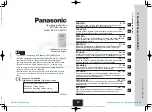
Page 2
IMPORTANT! The lightbar should be a minimum of 16" from any radio
antennas!
Mounting your Lightbar:
Refer to the Lightbar mounting guide included with your lightbar
Routing your Lightbar Cable(s)
1.
To protect the headliner from damage caused by drilling the cable access
hole through the vehicle roof, allow a 5” to 7” distance between roof and
headliner by lowering the headliner before drilling.
2.
Using a 1” hole saw, drill the cable access hole.
WARNING!There may be a roof support member that spans the
distance between the driver’s and passenger’s side. DO NOT DRILL
THROUGH THIS MEMBER! Adjust the location until the hole can be
drilled without contacting this support member.
3.
Use a round file to smooth and de-burr the edges of the hole.
4.
Insert a 1” grommet (user supplied) into the cable access hole.
5.
Insert the cable(s) through the cable access hole into the vehicle. Use RTV
silicone to weatherproof the access hole after the cable(s) are pulled
completely into the vehicle.
6.
Route the cable(s) down through the B-pillar. The cable(s) must make a 90°
turn to enter the B-pillar. Although routing the cable in this manner may be
difficult, this has been determined to be the best procedure. It is up to the
installation technicians discretion whether to route the cable(s) as
recommended or use an alternative route. Pull the full length of the cable(s)
out of the hole at the base of the B-pillar (Fig. 1) and route towards your
switch panel. Refer to the instructions included with your switches for switch
wiring information.
Connecting the Cables:
WARNING! All customer supplied wires that connect to the positive terminal of the battery must be sized to supply at least
125% of the maximum operating current and FUSED at the battery to carry that load. DO NOT USE CIRCUIT BREAKERS WITH
THIS PRODUCT!
Power Cable:
1.
Open the wiring shield lid (Fig. 4) and route the power cable into the wiring shield and towards the firewall.
2.
Follow the factory wiring harness through the firewall. It may be necessary to drill a hole in the firewall. If so, be absolutely sure that there are no
components that could be damaged by drilling. After the hole has been drilled, insert a grommet to protect the cable.
3.
Route the cable along the factory wiring harness towards the battery.
4.
Install a 20 amp fuse block (customer supplied) on the end of the RED wire in the power cable. Remove the fuse from the fuse block before
connecting any wires to the battery.
5.
Connect the fuse block to the POSITIVE (+) terminal on the battery. There can not be more than two (2) feet of wire between the fuse block and the
battery. The wire between the fuse block and the battery is “unprotected”, do not allow this wire to come into contact with any other wires.
6.
Connect the BLACK wire to the factory chassis ground adjacent to the battery.
Control Cable:
Extend the control cable to your switch panel and make the appropriate connections, using the information provided on Page 5. The control cable
connects to your control head or switch box and is fused there. Typical fusing is 5 Amps. Ap12VDC to a control wire will activate its function.
Cruise Lights / Auxiliary / White-Orange:
•
Low Cruise & Auxiliary (default)
•
High Cruise & Auxiliary
•
Cruise Off, Auxiliary Only
Low Power / Violet:
The type of switch used is dependant on how the operator wishes the Hi/Lo feature to function:
Latching Mode:
By ap12 VDC voltage to the Violet wire for less than 1 sec., the lightbar is “latched” into low power operation. The unit must be
turned off and then back on to restore normal, Hi power operation. (A Momentary Switch is Preferred)
Level Mode:
Ap12 VDC voltage to the Violet wire for more than 1 sec. holds the lightbar in low power mode until voltage is removed. (A Toggle
Switch is Preferred)
DRILLING THE CABLE ACCESS HOLE
Drill cable access hole in appropriate area
for your lightbar (see note)
FRONT OF LIGHTBAR
For
cables exiting
the Driver-side
of the extrusion
lightbars
with
For
cables exiting
the Passenger-side
of the extrusion
lightbars
with
FRON
T
WIRE SHIELD
B-PILLAR
(INSIDE VIEW)
CABLE EXIT HOLE
Fig. 1






















